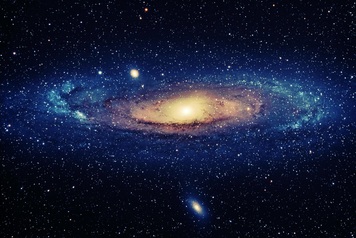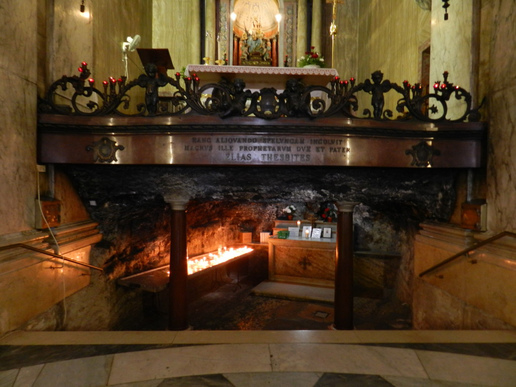 The Andromeda Galaxy’s trillion stars, 10,000 million trillion miles away
The Andromeda Galaxy’s trillion stars, 10,000 million trillion miles away Our Lord climbs Mount Tabor to pray with Peter, James, and John, and while he is praying, is transfigured: the fourth Luminous Mystery of the Rosary. Two weeks ago I too climbed Mt. Tabor, with 45 others from our parish, during our Holy Land pilgrimage. How wonderful to have been where Our Lord stood. We could see the fertile Valley of Jezreel, the limestone cliffs of Nazareth to the northwest, the Golan Heights to the east. What a grace to make that pilgrimage—you see the Scriptures as you hear them! So on Mount Tabor, Christ reveals his glory to Peter, James and John to strengthen their faith for the trauma of his Crucifixion. “This is my beloved Son,” a voice thunders from within the cloud. This is my Son, blazing with the radiance of the sun, with the glory of a billion stars. He will be humiliated on Good Friday, but he will be raised up, for the Creator of the Stars of Night cannot be conquered by darkness.
A Boy’s Telescope
When I was a kid I bought a telescope. With that treasure, I explored the heavens, gazing at galaxies and moons and planets, the rings of Saturn, the polar caps of Mars, the dusty lanes of stellar nebulae. As the apostles beheld Christ’s heavenly glory, let us also turn our telescopes to the heavens for a moment. On a clear night from a high mountain—Mt. Tam for instance—you can see hundreds of stars, a few planets, and the smoky edges of our own galaxy. That dull smudge is the Andromeda galaxy, 2.5 million light years distant (that’s 10,000 million trillion miles—the Lord owns a lot of real estate), which contains over a trillion stars. Both galaxies belong to the Local Group of about 50 galaxies, which belongs to a cluster, which clusters make up filament patterns of superclusters. My new favorite telescope, the Hubble, took a picture of the night sky the size of your thumb held at arm’s length and found 10,000 galaxies in that small dark spot. If every star (with its dozens of planets) were a grain of sand, the box to contain all the observable stars in the universe would have to be two miles high and two miles wide and stretch from New York to Atlanta. The universe is vast beyond our imagining, but God made man as the central jewel of creation: a creature to be loved for his own sake, and made capable of loving his Creator. But we are only capable of that love if we keep ourselves pure.
Your Sanctification
In the Epistle, St. Paul pleads with his beloved Christians at Thessalonica to imitate this immaculate whiteness of Christ. He earnestly urges them, in the Lord Jesus, “to refrain from immorality and lust…. God has not called us to impurity but to holiness.” As a mother would speak with her daughter, or a father his son, he addresses the delicate and burning issue of purity. “Conduct yourselves in a way pleasing to God… this is the will of God—your sanctification.” Paul defines “sanctification,” in this passage, as sexual purity. Holiness is more than chastity, of course, but bodily impurity severely limits our capacity to love God. “Every other sin,” St. Paul will say, “is outside the body,” but the impure man compromises the very temple of the Holy Spirit, which is his own body.
While He was at Prayer…
The world in which we live smears its filth on us at every turn, from television, movies and social media. You can hardly do a simple google search without getting contaminated by someone’s impurity. How can we maintain the purity in which God created us? How can we keep our place among the radiance of his sun and stars? We all know that only God can keep us pure, that we are powerless in the grip of our own lusts to either sexual impurity or base uncharity. It is for us to pray, from the heart, every day, to dispose ourselves. Notice that the glory of Our Lord’s immaculate purity was revealed while he was in prayer. That’s why, at Star of the Sea, we are putting all our time, money, and energy into Perpetual Adoration of the Eucharist. We must make our parish another Mount Tabor, a hilltop from which the radiance of Christ’s light beams over the City. Every parish must be so, and I believe the surest way is to develop a culture of Eucharistic prayer in every parish. May Our Lady, the Immaculata, Star of the Sea, shine her brilliant purity upon us, leading us to the glory of Christ himself.





 RSS Feed
RSS Feed